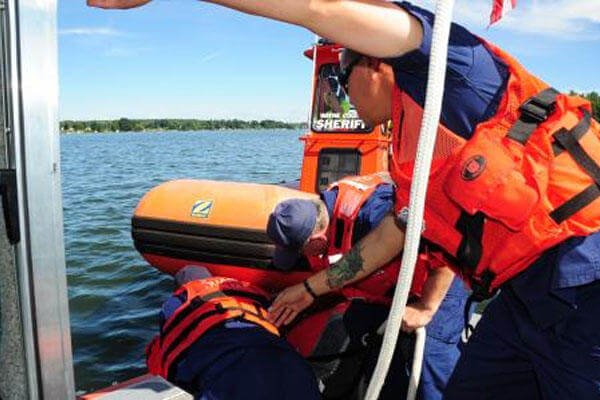There are millions of opportunities to volunteer in our world, but very few of those require expertise in something. In many cases, organizations are just grateful to have a few helping hands for a few hours. But, in the case of the Coast Guard Auxiliary, expertise is not only required but essential. When the Auxiliary gets involved, much like active-duty Coast Guard servicemembers, somebody’s life is going to be affected – nowhere is this truer than at an Auxiliary-operated Coast Guard station.
Coast Guard stations operated by the Auxiliary are just that – they are stations that can only operate at full capability with the help of volunteers. There are five Auxiliary-operated stations and 42 other smallboat stations in the Coast Guard 9th District, which comprises the entire Great Lakes region. Stations Sackets Harbor and Sodus Point, N.Y. are two of the five AUXOPs and are staffed year-round by only two active-duty Coast Guardsmen. Between Memorial Day and Labor Day, the peak boating season in northern New York, these two units are often staffed with two additional Coast Guard reservists through the Summerstock program. The Summerstock program allows qualified reservists to be activated for the summer boating season. They are used to fill billet gaps that exist throughout stations located on the Great Lakes.
Therefore, if any two of these four people are not available, the Coast Guard is not capable of responding to a distressed boater without the help of its volunteers from the Coast Guard Auxiliary.
A fully-staffed rescue boat crew has two qualified crew members and a coxswain.
Among the auxiliarists at Station Sackets Harbor, there is one qualified coxswain and three qualified boat crew members assigned to the unit with one 25-foot Response Boat-Small. At Station Sodus Point, there are three qualified crew members and two break-in crew members.
Station Sackets Harbor’s area of responsibility sits almost directly between full-time stations at Alexandria Bay and Oswego, N.Y. Both full-time stations are at least a 45-minute boat ride away from the center of Station Sackets Harbor’s area of responsibility.
Sackets Harbor’s AOR used to be covered full-time by Life-Saving Station Galloo Island, which was established June 20, 1874. The station was eventually disestablished in 1973 due to a lack of cases. Responsibilities of the station were taken over by the Coast Guard stations in Oswego and Alexandria Bay.
The seasonality of the 9th District allowed for the closing of the full-time station because the area is ultimately busier with boating traffic during the summer months.
“We are at the mercy of the availability of our qualified Auxiliary members,” said Chief Petty Officer Joshua Martin, officer-in-charge of Station Sackets Harbor. “Even when we have a couple extra bodies during the summer – if one of us gets sick or hurt, we are done without the Auxiliary personnel.”
However, some would say that a full Coast Guard crew is needed year-round because of Sackets Harbor’s no-limit ice fishing season, more shoreline than anywhere else in Jefferson County, the tourist attractions and the 10 public boat ramps in the station’s AOR.
Not to mention, there has been a water-based death in the area every April for three consecutive years, at a time when the station is not fully operational without the Auxiliary members being available.
Station Sodus Point is similar to Station Sackets Harbor, as it too is an Auxiliary-operated station that lies between stations Oswego and Rochester, N.Y.
In 1971, the Coast Guard budget was slashed so badly that many of the Coast Guard stations had to be closed including Sodus Point, which was closed on June 1, 1972. All regular personnel were transferred to other stations. This left a void in the Sodus Point area from any kind of help from the Coast Guard when there was a boat in trouble.
It would take an hour for a Coast Guard boat crew to transit from either Rochester or Oswego to Sodus Point.
“Being an Auxiliary member of Rochester Flotilla 2-4 and now living on Sodus Bay, I decided to organize a flotilla in this area,” said Vic Lupo, the first flotilla commander of AUXOP Station Sodus Point. “Rochester Flotilla was enthusiastic about the idea and acted as our sponsoring flotilla.”
And now the station hasn’t changed much except for the two full-time active-duty members assigned to the station.
“I wouldn’t say we are understaffed, but we are definitely minimally staffed,” said Chief Petty Officer Carey Jung, officer-in-charge of Station Sodus Point.
Except for the physical fitness standards, an auxiliarist has to meet the same requirements as an active-duty member to be a qualified boat crew member. An active-duty servicemember is given three months to earn the boat crew qualification. This is with working with boats every day, so imagine how difficult it can be for an auxiliarist who only works with the boats while on their own time.
“I enjoy participating in the station life and interacting with active-duty members,” said Dave Linder, a Coast Guard auxiliarist for 20 years and a current volunteer at Station Sodus Point. “We become friends and care about each other.”
“It starts a little selfishly by me getting some water time but ends up with me doing something useful with my time,” said Ray Walty, a Coast Guard auxiliarist at Station Sackets Harbor.
Being a boat crew member is an added responsibility on top of their other efforts as auxiliarists. There are many different qualifications an auxiliarist can choose to become proficient at, like: Auxiliary chef; boating safety instructor; vessel safety examiner; personal watercraft examiner; along with numerous others.
There are many reasons why somebody joins the Coast Guard Auxiliary, but possibly the most common reason is to serve one’s country. One example of this is Bill and Helen Cummings, of Utica, N.Y., auxiliarists with Flotilla 2-6. Bill and Helen have been active auxiliarists since just after the terrorists’ attacks on 9/11.
“We wanted to do something for our country,” said Bill.
“The Auxiliary chef position has been a very beneficial experience for us, as we have achieved an expertise in something,” said Helen. “You are never too old to learn.”
Station Oswego is one of the stations that benefits from the Auxiliary chef position. There is only one Coast Guard trained food service specialist assigned to the unit. The Cummings come in to work in the galley during surge operations that occasionally come through the area, like Oswego Fest, or when the food service specialist takes leave.
“We have been serving as Auxiliary chefs since before the position ever existed,” said Helen. “We saw a need, so we stepped in. We cooked a Thanksgiving Day meal for the unit a few years back, and we decided that there is nothing better than seeing the face of a new Coast Guardsman receiving a home-cooked meal for the first time away from home during a holiday.”
Another great example of the Auxiliary stepping in and taking the reins is as a communications watchstander at various stations in the Great Lakes. Boat crew training and responding to cases becomes easier and more feasible with the ability of stations to insert a qualified auxiliarist into the watchstander role to answer the all important distress calls.
All volunteers are special in their own way, but the thing that sets the Coast Guard Auxiliary apart from the rest — is their love for what they are doing. They all have a great desire to support the Coast Guard mission.
“I am enjoying my second stint in the Coast Guard, after a long hiatus in academia, some 34 years at the University of Rochester,” said John Braund, a Coast Guard auxiliarist and communications watchstander at Station Rochester. “I joined the Auxiliary about 15 years ago, seeing it as the best venue for me to offer support for Coast Guard missions of varying focus.”
The Coast Guard Auxiliary is more than 3,000 strong in the Great Lakes, with many of them being at least double and triple threats if not more. They are experienced in multiple areas of maritime expertise, but they all keep the messages pretty simple and share this same message – Wear your life jacket.
“During my 1,700 hours/year service time, I have taught and learned nothing more important than wearing your life jacket,” said Linder.
It may not be a perfect solution to operate as an AUXOP, but the men and women who staff these stations volunteer their time to keep the Coast Guard active in these remote areas. They are every bit the experts that active-duty Coast Guardsmen are, and sometimes even more so. For their efforts to teach others how to operate a boat safely, rescue a person in distress, examine a boat before it hits the water, or cook and serve a much needed meal, we salute you — the Coast Guard Auxiliary.




























